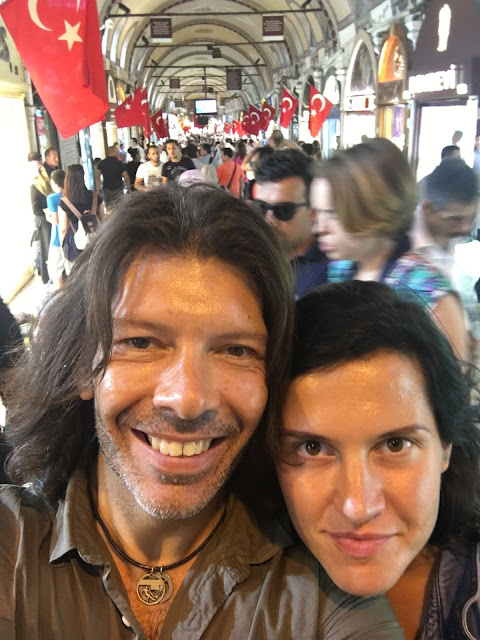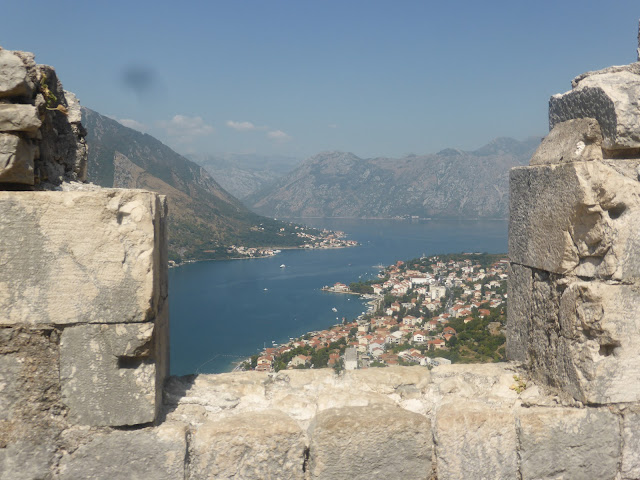Tbilisi (Georgia)
09 September - 12 September 2016
სიცოცხლე გაოცება - Life will surprise you
-->
09 September - 12 September 2016
სიცოცხლე გაოცება - Life will surprise you
Before I went to Georgia what I could tell you about the country could probably fit neatly onto the back of a postage stamp, meaning, I knew where it was located and I knew the name of the capital city - that was it!
Inga's father is from Georgia, I also knew that, which means that now, writing this blog from the year 2019, my son Aiden, is also part Georgian.
Where to start?
Georgian culture is an exotic, intoxicating and mysterious mix, containing elements of Anatolian, European, Persian, Arabic, Ottoman and Far Eastern cultures. By the very nature of its location, at the crossroads of Europe and Asia, its deliberately placed itself in the path of all-comers, and they in turn have influenced this country (and this city), stretching back millennia.
Inga, Davis, Annija and myself on Rustaveli Avenue - Tbilisi - Georgia
Tbilisi - Georgia
Tbilisi - Georgia
Tbilisi - Georgia
Tbilisi - Georgia
You can easily understand the strategic importance of a place like this. Its vector on the historic Silk Road enabled important trading from north, south, east and west. Sitting quite proudly at the junction of commerce, coupled with its own bounty of resources has formed a definitive amalgamation of cultures.
So, when I ask the question of where to start, I really mean, with a country as diverse, complex and in many ways, as fortunate a place it is, where in the world do you start? First perhaps, maybe the question of where Georgia resides. From my perspective, as a young boy staring down at the map of the world on my work desk, I would only see the words of the United Soviet Socialist Republic, with the big iconic hammer and sickle sticking out in my mind, and I would think - in my own ignorance - oh, that's just Russia. NO HENRY, NO IT'S NOT - not by any stretch of the imagination.
Tbilisi - Georgia - view from Narikala fortress
Tbilisi - Georgia - view from Narikala fortress
Tbilisi - Georgia - view from Narikala fortress
Narikala fortress - Tbilisi - Georgia
Narikala fortress - Tbilisi - Georgia
Old Tbilisi - Georgia
From a purely geographical standpoint its said, by some, that Europe stretches as far as the Caucasus Mountains range and in that sense, Georgia is considered to be the Eastern frontier of Europe. For the people themselves, it seems obvious that they in themselves feel to be European far more than anything else and the diplomatic, economic and social ties that they have pull them squarely into that realm.
What I discovered about Georgia is that its beauty comes from the potent mix of cultures that have moulded the country for thousand of years. You only need to look at their alphabet and written word to see that there's nothing like it, and, that there's a whole load of beautiful in something so mysterious. I found absolute სილამაზე (beauty) in the written word, a language that first appeared as an inscription in Palestine in 430AD and then shifted and shaped there after. Its all those influences that have acted to form something so entirely unique and unexpected in the fascinating city of Tbilisi.
Georgian flag
Churchkhela – Brown rubbery truncheons made from strings of
walnuts dipped in tatara and dried – this was quite often referred to as the ‘Georgian Snickers’.
Tbilisi - Georgia
Tbilisi - Georgia
Tbilisi - Georgia
I don't know what I was really expecting from Tbilisi, perhaps it was something more Arabic, more frenzied and ramshackled than the city I was introduced to. Lying on the banks of the Kura River, with a population of approximately 1.5 million, this is a city bounded on three sides by mountains and kinds of forms its own naturally large amphitheatre. In terms of architecture it has both a unique, and some would say uncanny way of mixing the old and the new, with commentators saying that in recent years Tbilisi has seen impressive structural development whilst at the same time bolstering its historical and cultural preservation. It's one of those cities that you get to realise in quite a hurry is truly flying under the radar of most tourists and travel guides. What I got to realising, that aside from the impressive vistas, this city is extremely cosmopolitan, that Georgian food is an absolute treat, the wine here is very good (in fact Georgians probably were the first to 'create wine'...and yes, you read that right), the nightlife is fantastic, the prices are excellent and the people are so friendly. Why Tbilisi hasn't made a Lonely Planet top 10 list to date just blows me away!!
Tbilisi is Inga's birthright. When I say that, it's that right of ownership that you associate from cultural heritage by descent. Our discovery of the city, a place that she had already been too previously, was on her, and I could see that there was a large degree of pride that she had in taking my around her father's city. That was pretty cool.
Some the highlights we took in were Narikala Fortress, a place that can be seen from any place in the city, as it stands proudly on a hill overlooking all and sundry. A fortress that was constructed for defence purposes in the 4th century now provides fantastic views out over Tbilisi for all those wanted to climb up, or, those who want to cheat and ride the funicular up to the top. Then there's Old Tbilisi, the picturesque old town with cobble stoned streets, the Art Nouveau buildings, the intricately designed and terraced master pieces were just a treat to see and truly inspiring. From an architectural perspective what the city has is considered to be a mix of Byzantine, Neoclassical, Art Nouveau, Middle Eastern & Soviet Modern - the latter unfortunately being the most bleak and stark, but the others, wow. Impressive in their style and presence, but cheated in some way by residing in a city/country that is still severely short of the needed funds to protect their wonderful heritage.
Tbilisi - Georgia
Tbilisi - Georgia
Tbilisi - Georgia
Tbilisi - Georgia
Tbilisi - Georgia
Old Tbilisi - Georgia
The Bridge of Peace is a bow shaped pedestrian bridge constructed of glass and steel - beautifully illuminated at night with LED lights, it cross the Kura River and is a highlight of central Tbilisi - Georgia
Another cool thing about Tbilisi is its night time culture, or to utilise an overused phrase from the SMH, it's 'night time economy'. This is a place that makes use of the 24hrs that exist in the day and just because the light gets replaced by the dark doesn't mean that life itself needs to shut down. On Shardeni street in central Tbilisi there are bars and restaurants aplenty, many with glorious rooftops that will allow you to take in the view of Tbilisi by night, especially the wonderful Narkiala Fortress.
Hard Rock Cafe - Tbilisi - Georgia
The Bridge of Peace - Tbilisi - Georgia
'Show me the LARI'
Hard Rock Cafe - Tbilisi - Georgia
Oh yeah, Shisha on Shardeni Street - Tbilisi - Georgia
Gabriadze Theatre - Tbilisi - Georgia
Again, this is where Tbilisi comes into its own once again as the options you have for food are just exceptional. With the likes of khinkali (twisted knobs of dough (dumplings) stuffed with meat and spices), khachapurri (a warm, gooey comfort food, cheese stuffed bread which can also be topped with egg), Badrijani (Roasted eggplant, served flat and topped with walnut paste), kebabs, shashlik, pkhali (a paste made from spinach, walnuts and garlic), lobio (a bean dish).............and then, once you get past that, the Georgian wine varietals, (Saperavi, Kindzmarauli, Tsinandali, Rkhatsiteli & Tvishi) amongst others, Georgia just becomes a phenomenal place to be for many, many reasons.
Then throw access to Shisha into that mix! BOOM - this was a freakin' wonderland.
Old Tbilisi - Georgia
Davis & Annija - in the time before they were a couple :)
Narikala Fortress from Old Tbilisi
Henry & Inga - from the time even before they were engaged (although, may I state - at this point I already knew where and when I'd be asking....)
Narikala Fortress from Old Tbilisi
Tbilisi - Georgia
Churchkhela - The Georgian Snickers
My time in Tbilisi with Inga, her brother Davis and his now wife Annija, (who wasn't even his girlfriend at the time - although more on that story when I do my Batumi entry), was ALL just the best experience. The atmosphere, the group of travellers and the city itself was just the right mix of everything that you needed, or rather, everything I didn't know that I needed but was given anyway.
Sometimes travel can surprise you in the greatest if ways, and to you Tbilisi alll I can say is,
'მშვენიერი ხარ'.









































































